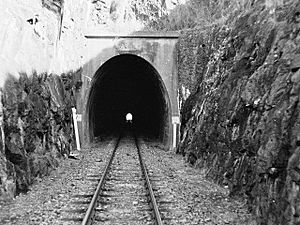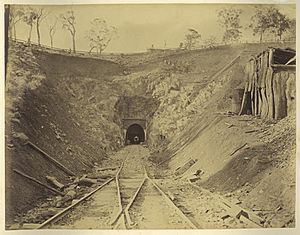Cherry Gully Tunnel facts for kids
Quick facts for kids Cherry Gully Tunnel |
|
|---|---|

Cherry Gully Tunnel
|
|
| Location | Warwick — Stanthorpe Line, Silverwood, Southern Downs Region, Queensland, Australia |
| Design period | 1870s - 1890s (late 19th century) |
| Built | 1878 - 1880 |
| Official name: Cherry Gully Tunnel, Gorge Tunnel | |
| Type | state heritage (built) |
| Designated | 28 July 2000 |
| Reference no. | 601517 |
| Significant period | 1870s, 1880s (fabric) |
| Significant components | cutting — railway, tunnel — railway |
| Builders | J & A Overend & Co |
| Lua error in Module:Location_map at line 420: attempt to index field 'wikibase' (a nil value). | |
The Cherry Gully Tunnel is a historic railway tunnel in Queensland, Australia. It is located on the railway line that connects Warwick to Stanthorpe. Builders J & A Overend & Co constructed the tunnel between 1878 and 1880. People also know it as Gorge Tunnel or Big Tunnel. This important structure was added to the Queensland Heritage Register on 28 July 2000.
Contents
Building the Railway
Why a Railway to Stanthorpe?
In the late 1860s and early 1870s, people in Queensland realized that railways were key to finding and moving valuable minerals. In 1877, the government decided to build several "mineral railways." These lines would connect mining towns to bigger cities. One important railway was the extension from Warwick to Stanthorpe. Stanthorpe was a booming area for tin mining. The railway would help transport the tin and other goods.
At first, Queensland built many separate railway lines. By 1891, there were eleven different systems! They were not all connected until 1924. That's when the North Coast Line opened, linking Brisbane to Cairns.
Planning the Route
The railway to Stanthorpe was a big deal for people in the southern tablelands. The line had already reached Warwick in 1871. In 1873, engineers started surveying the route to Stanthorpe. They found that the 41.5 miles (66.8 km) journey would need two expensive tunnels. One tunnel would be 29 chains (580 m) long, and another 13 chains (260 m) long. These tunnels would help avoid long detours.
In 1878, the final plans for the Warwick to Stanthorpe railway were ready. The project was split into two sections. Section one was about 20 miles (32 km) long. Section two covered the remaining 20 miles (32 km) to Stanthorpe.
Hard Work and New Ideas
The contract for Section 1 went to J&A Overend and Co. They started work in May 1878. Building the railway was tough, especially near the Cherry Gully tunnel. The rock was very hard. This section was known as the "Big Tunnel."
The builders set up a large camp near the tunnel site. To deal with the hard rock, they worked in two shifts, day and night. They even tried new drilling machines, but these didn't work well. So, workers had to drill by hand.
In a new idea for Queensland, builders used concrete instead of brick for some parts of the tunnel and bridges. This helped save money and was a success. The Cherry Gully Tunnel was one of the first in Queensland, and possibly Australia, to use concrete for its lining.
Life at the Construction Camps
The railway construction camps were like small, temporary towns. They had places to eat, shops, and sometimes even schools or churches. Many workers were from Irish families. They would celebrate special days, like St Patrick's Day, with races and fun events.
The work was dangerous, especially during blasting. But the workers made good progress. The line to Cherry Gully opened about five weeks later than planned. This was a great achievement, considering how difficult the tunnel was to build.
Water for the Trains
To keep the steam locomotives running, they needed a lot of water. In 1879, a concrete dam was built near the "big tunnel." This dam could hold 400,000 imperial gallons (1,800,000 L) of water. It was one of the earliest concrete dams built for water storage. The water flowed by gravity from the dam to a tank for the trains. Later, in 1914, a new water supply at Glen Niven meant this tank was not as important. By 1950, it was only used in emergencies.
The entire railway line from Cherry Gully to Stanthorpe officially opened on 1 May 1881.
About the Tunnel
The Cherry Gully Tunnel is located about 281 kilometres (175 mi) from Roma Street in Brisbane. It is part of the Southern Line, which runs between Warwick and Wallangarra. The tunnel is straight and measures 272 metres (892 ft) long. It has a rounded shape, like half an oval. Parts of the tunnel are lined with concrete and brick arches. The entrances, called portals, are also made of concrete.
Why is it Important?
The Cherry Gully Tunnel is a very important part of Queensland's history. It shows how railways were built in the late 1800s. It also highlights the new building methods used, like drilling machines and the experimental use of concrete.
This tunnel was a major engineering challenge on what became one of Queensland's busiest railway lines. Its survival and continued use help us understand how important the railway network was for Queensland's growth. The Cherry Gully Tunnel is a great example of smart engineering from that time.


